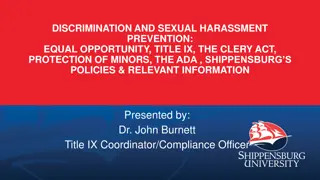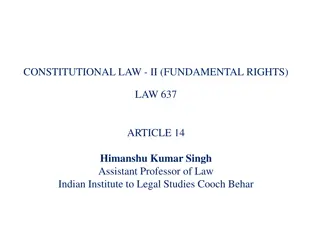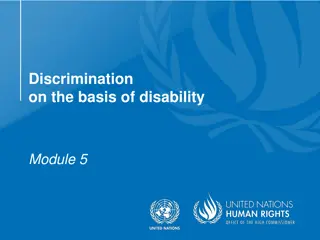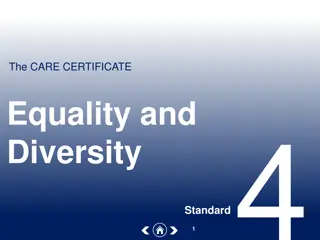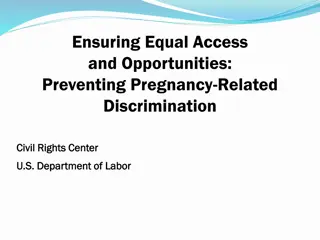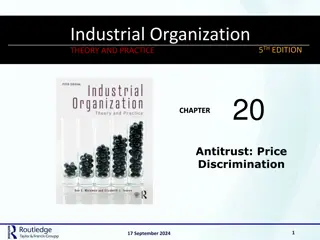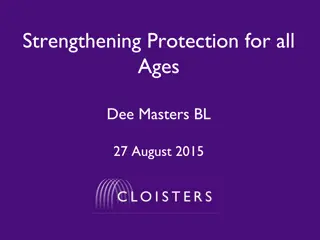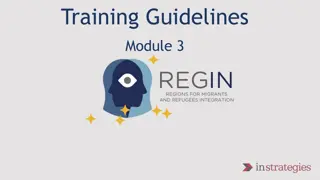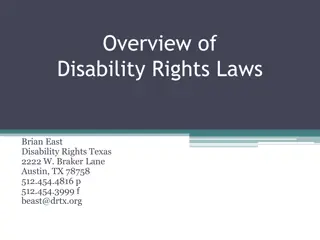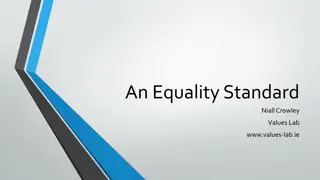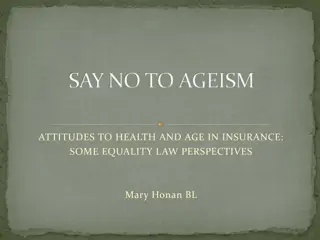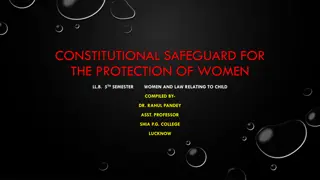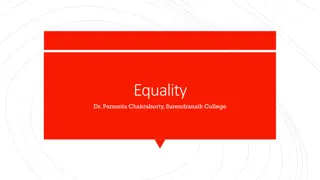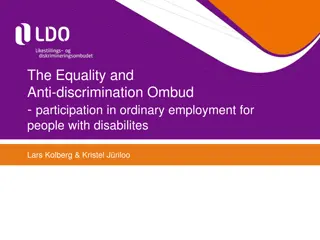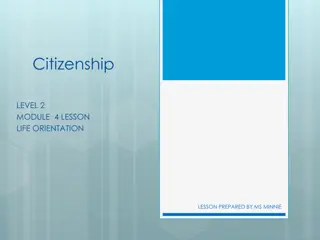Equality Act 2017: Ensuring Equal Access and Protection from Discrimination
The Equality Act 2017 aims to harmonise and extend statutory protection from discrimination for a wider range of people in various areas such as employment, goods and services, education, public functions, premises, and associations. It identifies nine protected characteristics including race, sex, religion or belief, sexual orientation, gender reassignment, marriage and civil partnership, pregnancy and maternity, age, and disability. Forms of discrimination include direct and indirect types, with specific considerations for direct discrimination through association and perception. The act strives to promote societal benefits such as kindness, compassion, respect, equal opportunities, fairness, less isolation, and inclusion.
Download Presentation

Please find below an Image/Link to download the presentation.
The content on the website is provided AS IS for your information and personal use only. It may not be sold, licensed, or shared on other websites without obtaining consent from the author. Download presentation by click this link. If you encounter any issues during the download, it is possible that the publisher has removed the file from their server.
E N D
Presentation Transcript
Equality Act 2017 Harmonise & extend statutory protection from discrimination for wider range of people Aim is to ensure equal access in: Employment Goods & Services Education Public Functions Premises Associations
Societal Benefits of Equality Equal Access Kindness, compassion & respects Equal Opportunities Societal Benefits of Equality Fairness Less Isolation Inclusion
9 Protected Characteristics 1. Race (includes colour, nationality, ethnic or national origin) 2. Sex 3. Religion or Belief (or lack of religion or belief) 4. Sexual Orientation 5. Gender Reassignment 6. Marriage and Civil Partnership 7. Pregnancy and Maternity 8. Age 9. Disability
Types of Discrimination Direct Indirect
Direct Discrimination Being treated less favourably on the grounds of a protected characteristic they possess. Cannot justify direct discrimination except on grounds of age
Direct Discrimination Through Association Direct discrimination against someone because of their association with a person who possesses a protected characteristic. Act will protect a disabled guest for example, as well as a person associated with that guest refusing the booking of a non-disabled couple because it was known they have a disabled child which they might bring with them making the carer of a disabled person sleep in the same room to ensure that they don t disturb other guests.
Direct Discrimination by Perception Discrimination based on the perception that a person possesses a protected Characteristic. Avoid treating someone less favourably because you think they have a particular characteristic
Indirect Discrimination Where a provision, criterion or practice is applied equally, but has the effect of putting a person with a protected characteristic at a disadvantage when compared to others.
Objective Justification Possible to defend indirect discrimination claim by arguing practice or treatment is justified. To be successful in the defence: 1. Show there is a good business reason legitimate aim 2. That the way of doing it is appropriate, necessary, fair and reasonable proportionate means and in doing so has considered any other less discriminatory ways of achieving the legitimate aim
HARASSMENT A person harasses another if that person engages in . Unwanted conduct in relation to a protected characteristic Which violates a person s dignity and creates a hostile, humiliating, intimidating, degrading or offensive environment Being treated less favourably due to rejection of or submission to unwanted conduct of a sexual nature or that is related to gender reassignment or sex Unwanted conduct of a sexual nature NB. CLAIMANT MAY NOT HAVE BEEN INTENDED RECIPIENT OF HARASSMENT
Victimisation Victimisation is when a person is subject to a detriment because they have (or are believed to have): Made an allegation of discrimination. Supported a complaint of discrimination. Given evidence relating to a complaint. Raised a grievance concerning discrimination.
Age Protects people of all ages both older and younger
Disability A disabled person is defined as someone who has:- a physical or mental impairment which has a substantial and a long-term adverse effect on their ability to carry out normal day to day activities. Cancer, MS, HIV and Aids are disabilities
Disability Discrimination Making reasonable adjustments Treating disabled persons more favourably because of their disability than non-disabled persons Failure to make reasonable adjustments is unlawful. Non-disabled person cannot claim discrimination on the grounds that they are treated less favourably.
Reasonable Adjustments Duty is anticipatory plan ahead Adjustments to a policy or procedure Adjustments involving the provision of auxiliary aids and services Adjustments to physical features Take advice Crossroads Care Tiered Award Scheme
Direct disability discrimination Make sure you treat disabled guests the same as you treat other guests. You would be treating guests with disabilities less favourably if you: refuse to serve them offer less favourable terms offer a lower standard of service compared with what you normally offer.
Disability Discrimination in employment You should not ask job applicants to complete a pre-employment medical questionnaire You should not ask health related questions generally unless: Exceptions: Employers can therefore ask health-related questions: to help decide if reasonable adjustments are needed in the selection process to determine if an applicant can carry out a function that is essential to the job such as heavy lifting, or for diversity monitoring purposes.
Disability arising from discrimination Differs from direct discrimination because of a protected characteristic person discriminated against must show less favourable treatment compared to a person without that characteristic. This discrimination cannot be objectively justified. Treating a disabled person unfavourably because of something arising in consequence of their disability. The treatment may be able to be objectively justified. Examples: banning a person with Tourette's syndrome from a bar area because their outbursts may offend other customers providing plastic cups and plates to a person with muscular dystrophy because you think that they might break items.
Examples of things connected to a disability: the need for regular toilet breaks the need to take time-off work long-term sickness absence restricted diet need for an assistance dog behavioural issues speech or movement difficulties difficulties reading and writing or understanding certain things the need for specialist computer equipment the need for a quiet working environment the need to use a wheelchair or other special equipment.
Reasonable Adjustments Financial Support Employment Disabled Persons (Employment) Scheme 1999 Up to 10,000 per applicant Services/Premises/Business Business Improvement Scheme - consultancy Government review to identify if scheme to support private sector to make reasonable adjustments can be offered
Gender Reassignment Provides protection for trans people someone who proposes to, starts or has completed a process, or part of a process, to change his or her sex. An individual does not have to be under medical supervision to be protected.
Gender Reassignment Respect the individuals right to be identified as the sex they have chosen Use the appropriate pronoun to the sex they identify with Don t ask for evidence of the sex they are Allow individual to use the toilets of the sex they have chosen Think about gender neutral toilets if this is an option Don t direct a trans person to the disabled toilet being trans is not a disability
Sexual Orientation Protects bisexual, gay, lesbian and heterosexual people from discrimination.
Bull v Preddy Mr & Mrs Bull, Christian hotel owners Mr Preddy & Mr Hall, civil partners Refused to honour booking of double room as such rooms reserved for heterosexual married couples only Court said Preddy & Hall directly discriminated against on the grounds of their sexual orientation Bulls argued right to manifest religious belief (human right) Court stated the right to manifest religious belief could be limited where it interfered with the rights of others Decision applied in Black v Wilkinson, B&B owner objected to sexual relations outside marriage; court stated direct discrimination on grounds of sexual orientation
Marriage and Civil Partnership Employees who are married or in a civil partnership are protected against discrimination. Single people and couples in relationships which are not legally recognised are not protected.
Pregnancy and Maternity Women are protected against discrimination on the grounds of pregnancy and maternity during the period of their pregnancy and any maternity leave to which they are entitled.
Race People are protected from discrimination because of their race. Race includes colour, nationality, ethnic or national origin. Howe v JD Wetherspoon
Religion or Belief People are protected from discrimination on the grounds of their religion or belief. Or if they don t have a particular religion or belief. Religion includes any religion which has a clear structure and belief system. A belief covers any religious or philosophical belief.
Sex The Act protects both men and women from discrimination because of their sex. Sex refers to the gender of an employee.
Job Advertisements Care with wording that is not discriminatory Is there a genuine occupational requirement Are you taking positive action to encourage applicants from under-represented groups?
Genuine Occupational Requirements - job advertisements Must be: Crucial to the post; Relating to the nature of the job not the culture of the organisation; You have a real business need and what you are proposing is appropriate, reasonable, necessary and fair ( Proportionate means of achieving a legitimate aim )
Interviews Reasonable adjustments required before interview or selection process? Flexibility with interview dates/times Don t ask about someone s protected characteristics unless very clearly related to the job Don t ask about health, sickness or disability records if disabled, focus on person s ability to do the job and what RA are needed Avoid making instant and unfair judgments as soon as someone arrives establish their skills, qualities & experience Keep record of interview and notes for 12 months
Questions to avoid in interviews Are you married? How old are you? What is your date of birth? How many children do you have? What does your husband do? What does he think of you applying for this role? How do you feel about managing a team of younger people? What church do you go to? When do you plan to retire? Which political party do you belong to?
Liability Personal employee liability for the discriminator/harasser/victimiser Vicarious liability for employer for acts in the course of employment unless defence that all reasonable steps taken can be shown Criminal liability for false or misleading statements ( 5k) Reputational and/or financial risks
EASS statistics Equality & Advisory Support Service 2017 96% - cases resolved informally 3% - EASS direct intervention 1% - formal resolution Highlands & Islands Jan Aug 2018 55 cases Highlands & Islands Jan Aug 2018 Disability 87.5% Gender 7.5% Pregnancy & Maternity 2.5% Race 2.5% Education 3.6% Premises 3.6% No discrimination identified 14.5% Services & Public Functions 40% Work 38.2%
Next steps Train you, employees and contractors in equality issues Review policies/practices, written or not Review website & advertisements; check wording; think about inclusive pictures Consider having an equality policy Review your accessibility for disability and make your customers aware Consider reasonable adjustments carefully take advice Be sensitive to needs; ask/listen Make sure complaints are dealt with; manage poor behaviours
Can we reverse the trend through equality? Visitor Numbers 400,000 350,000 300,000 250,000 200,000 150,000 100,000 50,000 0 1985 1992 2016 2017 Visitor Numbers



